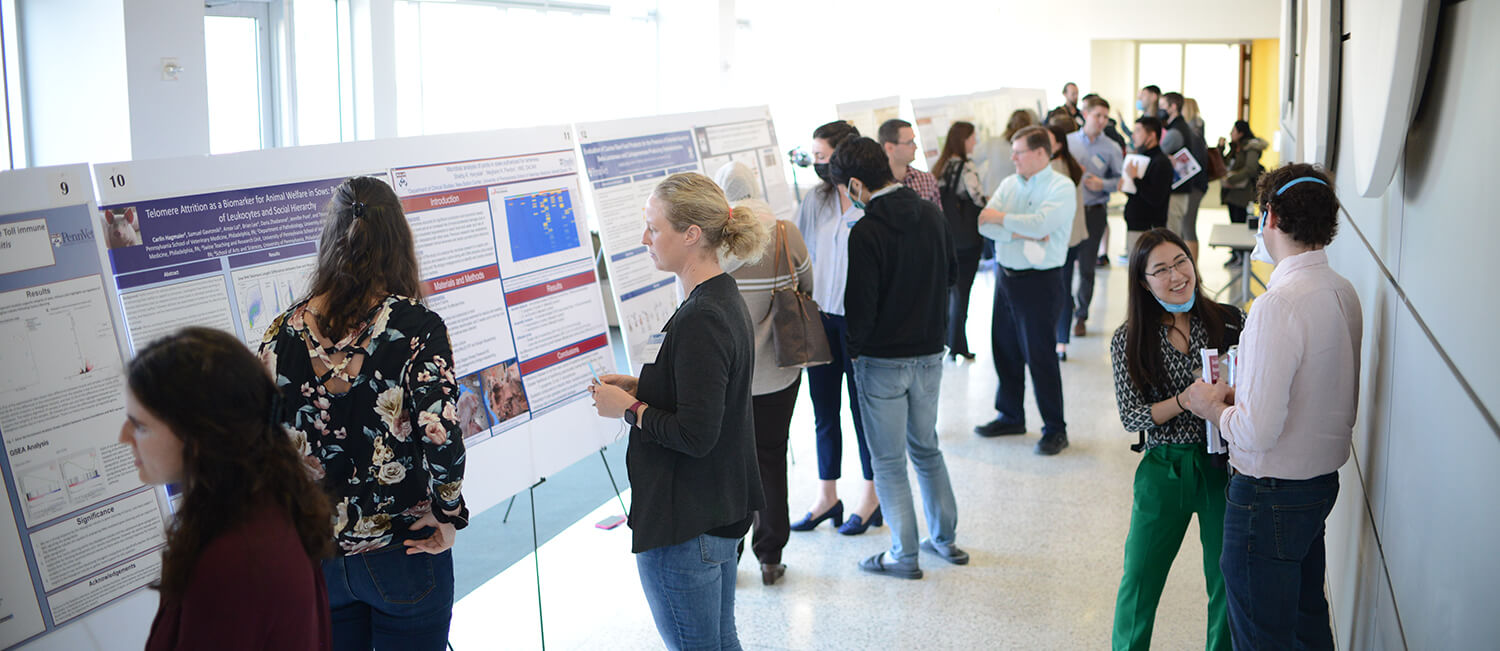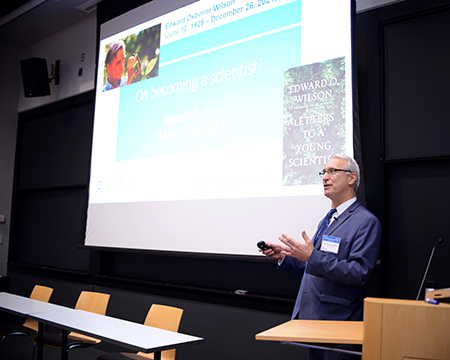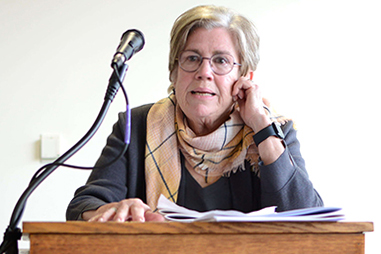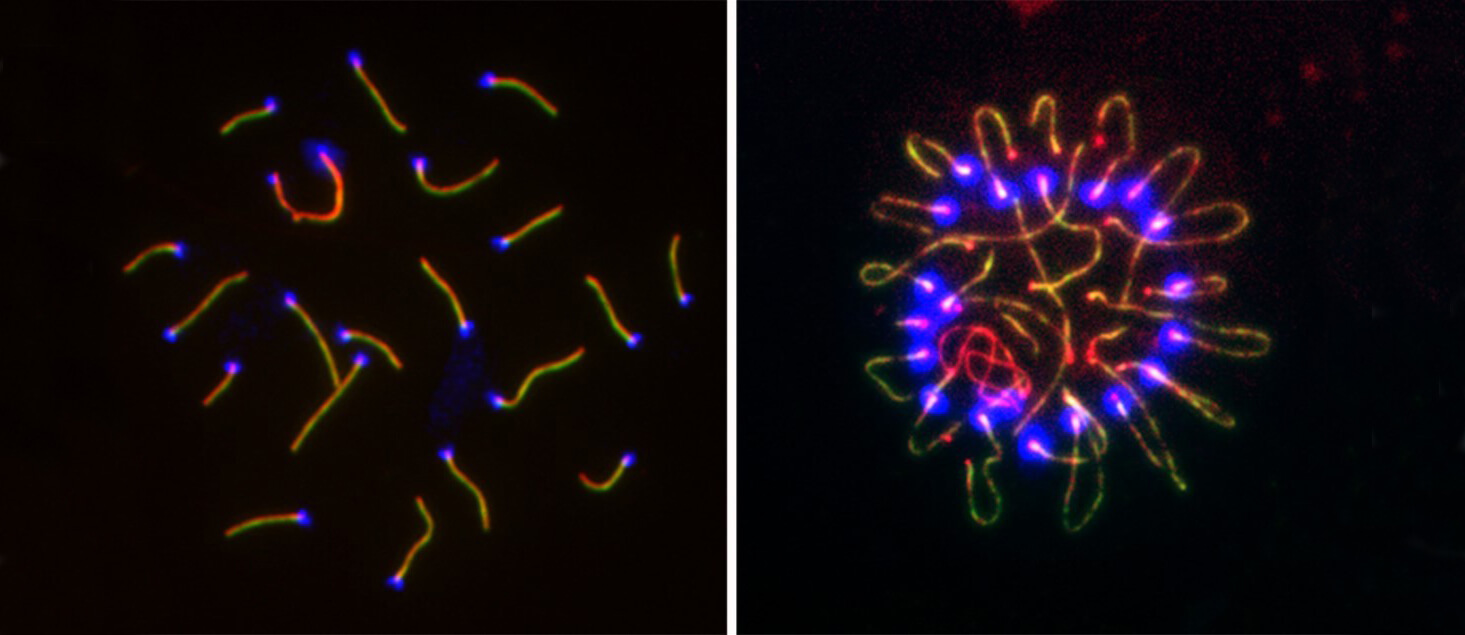
Student Research Day
Penn Vet’s Student Research Day was held on Friday, March 18, 2022, in the Vernon and Shirley Hill Pavilion. Due to the COVID-19 pandemic, this year marked the first time the event had been held in person since 2019. The organizing committee was led by Professor Jennifer Punt and included faculty members Elizabeth Lennon, Michael May, and Phillip Scott, and members of the Student Research Club, Daria Mrugala, Nimisha Pattada, and Stephanie Sila.
 Dean Andrew Hoffman kicked off the day’s events with an inspiring introduction focusing on the importance of science and scientists in today’s world. Three VMD students (Jo Kawabata, Amelie Ya Deau, and Hanna Zayas) and three VMD/PhD students (Suna Cranfill, Sabina Hlavaty, and Martha Stone) delivered oral presentations, and 29 posters were presented. Professor Susan VandeWoude, director of the One Health Institute at Colorado State University, delivered a fascinating keynote presentation entitled SARS-CoV-2 infections in felids of all sizes: Implications for human and animal health.
Dean Andrew Hoffman kicked off the day’s events with an inspiring introduction focusing on the importance of science and scientists in today’s world. Three VMD students (Jo Kawabata, Amelie Ya Deau, and Hanna Zayas) and three VMD/PhD students (Suna Cranfill, Sabina Hlavaty, and Martha Stone) delivered oral presentations, and 29 posters were presented. Professor Susan VandeWoude, director of the One Health Institute at Colorado State University, delivered a fascinating keynote presentation entitled SARS-CoV-2 infections in felids of all sizes: Implications for human and animal health.
Academic prizes were awarded for three poster presentations (Isabella Healy, Ariel Shepley-McTaggart, and Anna Smith), and all six student oral presentations. This year’s academic prizes for oral and poster presentations were named for Professor Emeritus Richard O. Davies. Faculty judges for the abstracts and posters included Eman Anis, Andres Blanco, Brian Flesner, Jennifer Lenz, Andrew Modzelewski, Lisa Murphy, and Kotaro Sasaki.
Student Research Day also included a ‘poster slam’ competition. Each poster presenter provided a one-minute video and one slide to introduce their poster. These introductions were compiled into a single video that played on a loop in Marookian Auditorium during the poster session. Prizes were awarded in three categories: Clear, Creative, and Crazy. Winners were chosen by popular vote and included Brianna Blunck and Carlin Hagmaier (Clear category); Maria Pansulla and Ariel Shepley-McTaggart (Creative category); and Justin Hoffman (Crazy category).
 During the reception, Gayle Joseph, Senior Research Resources Manager, who retired in January 2022, was honored for her tireless advocacy for research at Penn Vet and was recognized for transforming Student Research Day into a vibrant, professional event.
During the reception, Gayle Joseph, Senior Research Resources Manager, who retired in January 2022, was honored for her tireless advocacy for research at Penn Vet and was recognized for transforming Student Research Day into a vibrant, professional event.
Student Research Day presentations are available for online viewing.
Researchers from Boris Striepen's lab tracked Cryptosporidium in real time, creating a new paradigm for how the widespread parasite reproduces in a host.
.png?sfvrsn=9f9afbba_2) A single injection of gene therapy containing a normal version of the LRIT3 gene resulted in lasting restoration of night vision in dogs affected by a form of congenital stationary night blindness similar to one affecting humans. (Image: Courtesy of Keiko Miyadera)
A single injection of gene therapy containing a normal version of the LRIT3 gene resulted in lasting restoration of night vision in dogs affected by a form of congenital stationary night blindness similar to one affecting humans. (Image: Courtesy of Keiko Miyadera)
In the Proceedings of the National Academy of Sciences, Keiko Miyadera, William Beltran, and Gustavo Aguirre, reported on a gene therapy that returns night vision to dogs born with congenital stationary night blindness (CSNB).
Monserrat Anguera launched a new path of research into sex differences in coronavirus infection in collaboration with Andrew Vaughan. Together they developed a mouse with a humanized version of the ACE2 gene to study hormonal and genetic contributions to the pathologies from SARS-CoV-2 infection. Ronald Harty’s work in antiviral compound assays may also prove valuable in this or future pandemics.
.jpeg?sfvrsn=eeacfbba_2) An imagined scene from the end of the Cretaceous Period, more than 66 million years ago, has the newly identified softshell turtle Hutchemys walkerorum dwelling alongside iconic species from the Age of the Dinosaurs. (Image: Sergey Krasovskiy)
An imagined scene from the end of the Cretaceous Period, more than 66 million years ago, has the newly identified softshell turtle Hutchemys walkerorum dwelling alongside iconic species from the Age of the Dinosaurs. (Image: Sergey Krasovskiy)
Peter Dodson served as a collaborator and advisor on research led by doctoral student Steven Jasinski that led to the identification of a softshell turtle that lived in North Dakota 66.5 million years ago at the end of the Cretaceous Period, just before the end-Cretaceous mass extinction.
Elizabeth Lennon, Olivia Lenz, Stephen Cole, and researchers from the Perelman School of Medicine identified a domestic house cat, treated at Penn Vet’s Ryan Hospital, that was infected with the delta variant of SARS-CoV-2 subsequent to exposure from its owner.
Eman Anis, Erick Gagne, and researchers at the Perelman School of Medicine are studying the prevalence of SARS-CoV-2 in white-tailed deer across the state of Pennsylvania. The Wildlife Futures Program is a partnership between Penn Vet and the Pennsylvania Game Commission.
 In a recent study by P. Jeremy Wang, inactivating the gene YTHDC2, which is required for meiosis to progress through all of its proper stages,
In a recent study by P. Jeremy Wang, inactivating the gene YTHDC2, which is required for meiosis to progress through all of its proper stages,
led to an odd clustering of chromosome ends (at right).
Three papers published by the laboratory of P. Jeremy Wang illuminate different aspects of reproduction: sperm motility and a potential contraceptive target; recurrent pregnancy loss; and the intricacies of meiosis.
A sampling of stories from February and March 2022 highlighting the work of Penn Vet and its faculty.
A sampling of stories from December 2021 and January 2022 highlighting the work of Penn Vet and its faculty.